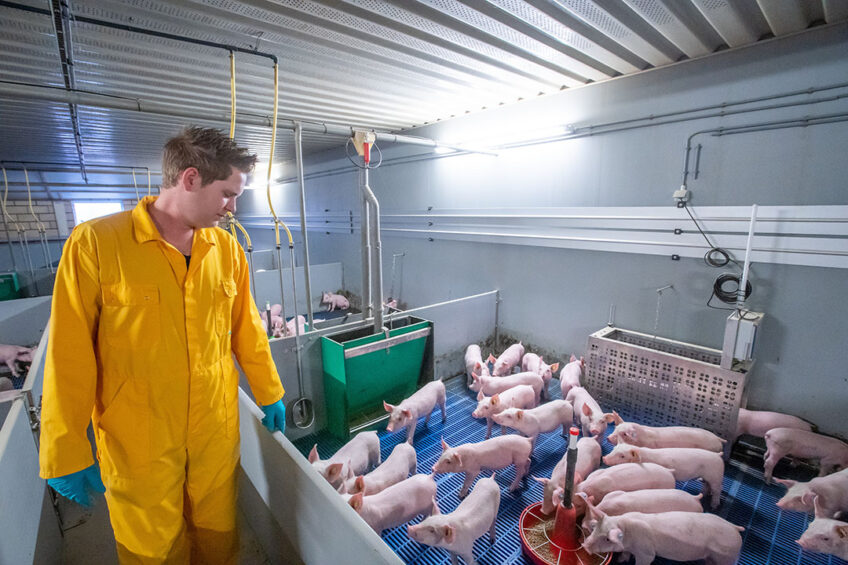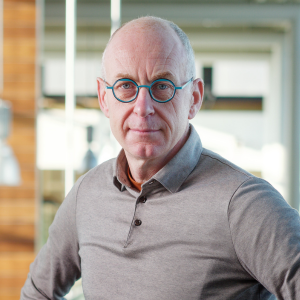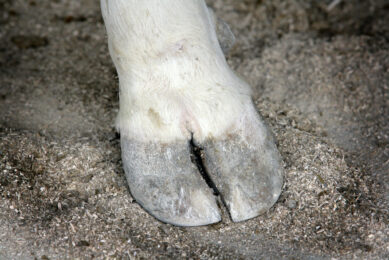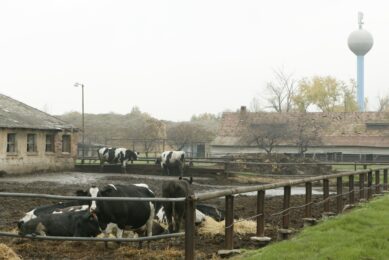FARM VISIT: Capacity problems vanish with better weaner care

Pig producer Roy Hannen, based in the south of the Netherlands, likes to think differently. He created additional space inside the pig house simply by increasing the pig flow. Working consistently is an absolute necessity.
When a grower pig house reaches the limits of its capacity, there are 2 main ways this can be overcome. One is to create additional places; the other is to make sure the animals grow faster. Pig producer Roy Hannen, located in Heibloem, Limburg province, the Netherlands, decided to go for the second option. For both visitors as well as himself he has raised the bar considerably and continues to strive for better results with his pigs.
To achieve higher performance levels in his grower pig houses, he decided early in 2020 to go for the TOP strategy, which is a joint approach by animal nutrition company Agrifirm and MS Schippers. The concept revolves around maximum farm hygiene, matching nutrition and monitoring the results to ensure that targeted improvement is constantly possible.
In the grower house Hannen has been working with MS Schippers’ HyCare method, which translates to a very organised appearance inside the farm. The floor and the lower part of the central aisle have been coated, as have the stone walls inside the pig house.
In each section there’s a hand disinfection gel dispenser plus baskets for plastic gloves. Each section has Birkenstock footwear that can only be worn in that specific section. That way, germ spreading between sections is reduced to a minimum – at least, that is the philosophy.

The central aisle and the different sections are extremely tidy and neatly organised. HyCare demands a consistent way of working from the pig producers, their staff and the visitors who enter the farm. Hannen says, “I’m convinced that the HyCare system can be successfully implemented. But it’s something that should appeal to you. Once the entire management is up and running and interdependent, you’ve got to continue to work consistently. Colleagues often think that this approach requires a lot of work. But that’s not the case. I can look after 4,000 piglets in one hour. And pleasure in work also increases when the animals thrive and are healthy.”

Small adjustment
To make the pig house fit for HyCare, a couple of adjustments were necessary. The only thing Hannen had to pay for was the floor and wall coating – and that’s an investment he would immediately make again. Apart from the fact that the floors are easy to clean, the animals now have a lot more grip on the coated floors. Slippery surfaces have ceased to exist for both sows and piglets, which is why Hannen is content.
The dispensers, shoes, coveralls, acid pump, etc., all form part of the concept costs. Rodent and fly control and mobile scales to monitor piglet growth are also included.

Another important step was to change the waterworks. Each section received its own set of pipes which are connected directly to the technical room. The new pipes are much narrower than the ones installed previously, which causes the water to flow faster. If the water does not flow fast, it creates a potential harbour for pathogens in the normally warm surroundings of a grower pig department. Hannen was really surprised when the old pipes were removed from the pig house. He says, “I was flabbergasted to see how filthy the pipes had become.” Nowadays dirty pipes are a thing of the past. Monitoring of the water quality forms part of the piglet rearing package. By using acids as well as cleaning substances, the pipes are certain to remain clean.

Growth increase of 40g
After an initial trial and error phase, the grower pig approach has reaped rewards. The HyCare system took its time before it started to pay off, Hannen noticed. Nevertheless, growth increased by 40g/day. Between 7.5kg and 24kg, the growth is currently at 390g/day, with mortality at 1%, compared to 1.2% in the past. Post-weaning diarrhoea has disappeared, and things are running just fine in the grower house, he says.
Yet he wants more. He believes that piglet uniformity can be improved. To achieve that, he is looking at the total production cycle, from sow insemination through to weaning. Hannen believes that by applying a few tweaks in the gestation and lactation phase, the piglets will look even better after weaning.

The piglets have been placed in pens of 30 and have been sorted for weight and gender. All capacity problems have vanished; on the contrary, there’s room left. Hannen says, “If growth is disappointing, even with 5,000 weaner-place capacity there’s still a shortage. Nowadays, however, I have extra space, which just enhances growth and reduces the workload.”
For Hannen, pig health is the key to success. “Purchasing” animal health is not his thing, he says – the only vaccinations the pigs get is for Porcine Circovirus 2 (PCV2). He just wants to keep his piglets (TN70 sow x Tempo boar) healthy. Hannen says, “Everything starts with animal health. Vaccinations should not be necessary – or only to a minimum degree.”
Investments
For the total TOP grower strategy, Hannen pays € 0.66 per grower pig place per month. He receives a reduction of € 0.17 per place because he is using the exclusive Agrifirm/MS Schippers deal. A small part of the additional costs are compensated because the piglet feed has become a little cheaper.
Acids that used to be part of the feed now go into the drinking water. In addition, the energy values in the feed have dropped slightly.
Hannen says it is hard to support with figures the benefits of the grower pig strategy. What angles do you use for the calculations?
That remains a bit arbitrary. Technical performance has definitely improved: the farm is not running at full capacity and the pig producer spends an hour dealing with 4,000 piglets. That is calculable.

He does not have to worry about flies, drinking water, rodents or sufficient on-farm clothing. That is all taken care of, as part of the fixed price. The effect of vital piglets is also noticeable in the finisher pig compartment; growth there is almost 1kg/day. If this trend continues, the 2021 average may even exceed 1kg/day. In that compartment the same rule applies – once the right path is found, things become smoother. If the pigs grow faster, capacity problems disappear and more pens can be kept empty between new inhabitants. All these effects would normally contribute to better technical performance results – and that’s exactly Hannen’s philosophy. In his view it just needed to take off.

Farm visits
With an interactive map Pig Progress takes you around the world one pig production farm at a time.
Implementing the system successfully is perfectly in line with his personality. He was already a neat and precise character and demands his staff to have a similar attitude. By using HyCare he just dotted the i’s and crossed the t’s in the grower pig department. All staff are paying more attention to getting dressed correctly, using syringes properly, choosing clean towels and paying attention to drinking water quality. Hannen says, “All staff have to appreciate the added value. Otherwise the advantages disappear quickly again.”











